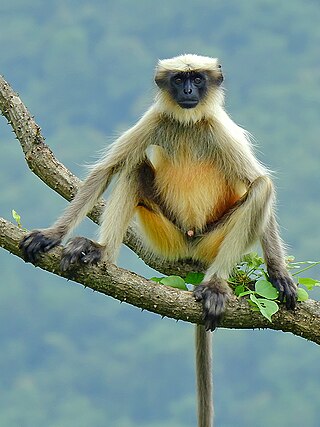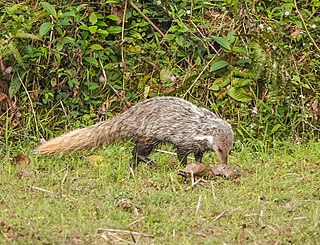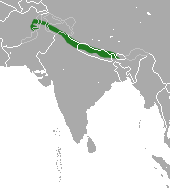
Semnopithecus is a genus of Old World monkeys native to the Indian subcontinent, with all species with the exception of two being commonly known as gray langurs. Traditionally only one species Semnopithecus entellus was recognized, but since about 2001, additional species have been recognized. The taxonomy has been in flux, but currently eight species are recognized.

The purple-faced langur, also known as the purple-faced leaf monkey, is a species of Old World monkey that is endemic to Sri Lanka. The animal is a long-tailed arboreal species, identified by a mostly brown appearance, dark face and a very shy nature. The species was once highly prevalent, found in suburban Colombo and the "wet zone" villages, but rapid urbanization has led to a significant decrease in the population level of the monkeys. It had traditionally been classified within the genus Trachypithecus but was moved to the genus Semnopithecus based on DNA evidence indicating that is it more closely related to the gray langurs.

The Arunachal macaque is a macaque native to Eastern Himalayas of Bhutan, China and India. It is listed as Endangered on the IUCN Red List.

Trachypithecus is a genus of Old World monkeys containing species known as lutungs, langurs, or leaf monkeys. Their range is much of Southeast Asia.

Gee's golden langur, also known as simply the golden langur, is an Old World monkey found in a small region of Western Assam, India and in the neighboring foothills of the Black Mountains of Bhutan. Long considered sacred by many Himalayan people, the golden langur was first brought to the attention of the Western world by the naturalist Edward Pritchard Gee in the 1950s. Adult males have a cream to golden coat with darker flanks while the females and juveniles are lighter. The golden langur has a black face and a long tail up to 50 cm (19.69 in) in length. It lives in high trees and has a herbivorous diet of fruits, leaves, seeds, buds and flowers. The average group size is eight individuals, with a ratio of several females to each adult male. It is one of the most endangered primate species of India and Bhutan.

The Nilgiri langur is a langur. This primate has glossy black fur on its body and golden brown fur on its head. It is similar in size and long-tailed like the gray langurs. Females have a white patch of fur on the inner thigh. It typically lives in troops of nine to ten monkeys. Its diet consists of fruits, shoots and leaves. The species is classified as vulnerable due to habitat destruction and poaching for its fur and flesh, the latter believed to have aphrodisiac properties.

The black-footed gray langur is an Old World monkey, one of the species of langurs. Found in southern India, this, like other gray langurs, is a leaf-eating monkey.

The barasingha, sometimes barasinghe, also known as the swamp deer, is a deer species distributed in the Indian subcontinent. Populations in northern and central India are fragmented, and two isolated populations occur in southwestern Nepal. It has been extirpated in Pakistan and Bangladesh, and its presence is uncertain in Bhutan.

The crab-eating mongoose is a mongoose species ranging from the northeastern Indian subcontinent and Southeast Asia to southern China and Taiwan. It is listed as Least Concern on the IUCN Red List.

The northern plains gray langur, also known as the sacred langur, Bengal sacred langur and Hanuman langur, is a species of primate in the family Cercopithecidae.

The capped langur is a species of primate in the family Cercopithecidae. It is native to Bangladesh, Bhutan, India, and Myanmar. Its natural habitat is subtropical or tropical dry forests. It is threatened by habitat loss. They are arboreal and gregarious by nature. A herd of capped langurs consists of 2 to 14 langurs led by a single male. They are herbivorous, eating leaves, twigs, buds and fruits.

The Bhutan giant flying squirrel, also known as the Gray's giant flying squirrel or noble giant flying squirrel, is a species of rodent in the family Sciuridae. This species lives in Himalayan forests and it is one of the largest flying squirrels. Like other flying squirrels, it is mainly nocturnal and able to glide long distances between trees by spreading out its patagium, skin between its limbs.

Southern plains gray langur was the common name ascribed to Semnopithecus dussumieri by Mammal Species of the World in 2005. Along with several other Semnopithecus, it had been previously considered a subspecies of the northern plains gray langur, Semnopithecus entellus, i.e., Semnopithecus entellus dussumieri. Subsequent genetic research has revealed that Semnopithecus dussumieri is an invalid taxon. These monkeys live in groups in forests and other rural habitats, with some groups being habituated to human contact and feeding. They are herbivorous, feeding by day mainly on foliage, fruits and flowers, and sleeping at night high in a tree.

The Kashmir gray langur is an Old World monkey, one of the langur species. It is a leaf-eating monkey.

The Tarai gray langur is an Old World monkey, and was formerly considered a subspecies of the northern plains gray langur. The species is listed as near threatened, as there are probably not many more than 10,000 mature individuals, and it is experiencing a continuing decline.

The tufted gray langur, also known as Madras gray langur, and Coromandel sacred langur, is an Old World monkey, one of the species of langurs. This, like other gray langurs, is mainly a leaf-eating monkey. It is found in southeast India and Sri Lanka. It is one of three Semnopithecus species named after characters from The Iliad, S. hector and S. ajax being the others. In Sinhala it is known as හැලි වදුරා.
The ecology of the Himalayas varies with climate, rainfall, altitude, and soils. The climate ranges from tropical at the base of the mountains to permanent ice and snow at the highest elevations. The amount of yearly rainfall increases from west to east along the southern front of the range. This diversity of climate, altitude, rainfall and soil conditions supports a variety of distinct plant and animal species, such as the Nepal gray langur

Raimona National Park is located in extreme western part of Assam, India. It is spread across Gossaigaon and Kokrajhar subdivisions of Kokrajhar district of Bodoland Territorial Region.



















